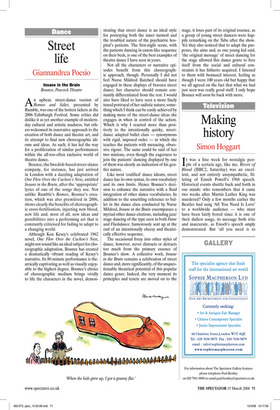Street life
Giannandrea Poesio
Insane in the Brain Bounce, Peacock Theatre
An upbeat, street-dance version of Romeo and Juliet, presented by Rumble, was one of the hottest tickets at the 2006 Edinburgh Festival. Some critics did dislike it as yet another example of modernday cultural and artistic madness, but others welcomed its innovative approach to the creation of both dance and theatre art, and its attempt to find new choreographic idioms and ideas. As such, it has led the way for a proliferation of similar performances within the all-too-often exclusive world of theatre dance.
Bounce, the Swedish-based street-dance company, for instance, has just arrived in London with a dazzling adaptation of One Flew Over the Cuckoo’s Nest, entitled Insane in the Brain, after the ‘appropriate’ lyrics of one of the songs they use. Not unlike Rumble’s Romeo, Bounce’s creation, which was also premièred in 2006, shows clearly the benefits of choreographic cross-fertilisation, injecting new blood, new life and, most of all, new ideas and possibilities into a performing art that is constantly criticised for failing to adapt to a changing world.
Although Ken Kesey’s celebrated 1962 novel, One Flew Over the Cuckoo’s Nest, might not sound like an ideal subject for choreographic adaptation, Bounce has created a dramatically vibrant reading of Kesey’s narrative. Its 80-minute performance is theatrically captivating as well as visually enjoyable to the highest degree. Bounce’s choice of choreographic medium brings vividly to life the characters in the novel, demon strating that street dance is an ideal style for portraying both the inner turmoil and the troubled nature of the psychiatric hospital’s patients. The first-night scene, with the patients dancing in canon-like sequence on their beds, is one of the best examples of theatre dance I have seen in years.
Not all the characters or narrative episodes benefit from this choreographic approach, though. Personally I did not feel Nurse Mildred Ratched should have engaged in these displays of bravura street dance; her character should remain constantly differentiated from the rest. I would also have liked to have seen a more finely tuned portrayal of her sadistic nature; something which I think can be easily achieved by making more of the street-dance ideas she engages in when in control of the action. Which is why I reacted more than positively to the intentionally quirky, streetdance adapted ballet class — synonymous with rigid, imposed order — in which she teaches the patients with menacing, obsessive rigour. The same could be said of her two minions, even though the eagerness to join the patients’ dancing displayed by one of them was clearly an indication of his gentler nature.
Like most ‘codified’ dance idioms, street dance has its own syntax, its own vocabulary and its own limits. Hence Bounce’s decision to enhance the narrative with a fluid integration of other dance vocabularies. In addition to the unsettling reference to ballet in the dance class conducted by Nurse Mildred, Insane in the Brain encompasses a myriad other dance citations, including jazz/ stage dancing of the type seen in both Fame and Flashdance, humorously sent up at the end of an intentionally cheesy and theatrically effective sequence.
The occasional foray into other styles of dance, however, never distracts or detracts too much from the primary essence of Bounce’s show. A collective work, Insane in the Brain remains a celebration of street dance and, more significantly, of the unquestionable theatrical potential of this popular dance genre. Indeed, the very moment its principles and tenets are moved on to the stage, it loses part of its original essence, as a group of young street dancers were happily remarking on the Tube after the show. Yet they also noticed that to adapt the purposes, the aims and, as one young kid said, ‘the original message’ of street dancing for the stage allowed this dance genre to free itself from the social and cultural constraints it has hitherto acquired. I listened to them with bemused interest, feeling as though I were 100 years old but happy that we all agreed on the fact that what we had just seen was really good stuff. I only hope Bounce will soon be back with more.


























































































 Previous page
Previous page